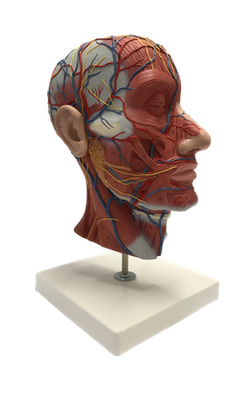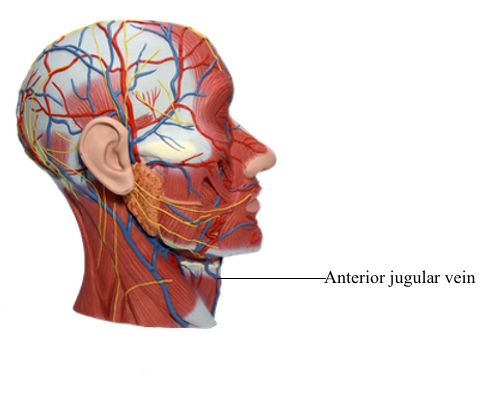Main Model

Blood Vessels : 62 Anterior jugular vein

Root of Neck
The root of the neck is the junctional area between the thorax and neck. It is located on the cervical side of the superior thoracic aperture, through which pass all structures going from the thorax to the head or upper limb and vice versa. The inferior boundary of the root of the neck is the superior thoracic aperture, formed laterally by the 1st pair of ribs and their costal cartilages, anteriorly by the manubrium of the sternum, and posteriorly by the body of T1 vertebra.
Veins in Root of Neck
Two large veins terminating in the root of the neck are the EJV, draining blood received mostly from the scalp and face, and the variable anterior jugular vein (AJV), usually the smallest of the jugular veins. The AJV typically arises near the hyoid from the confluence of superficial submandibular veins. The AJV descends either in the subcutaneous tissue or deep to the investing layer of deep cervical fascia between the anterior median line and the anterior border of the SCM. At the root of the neck, the AJV turns laterally, posterior to the SCM, and opens into the termination of the EJV or into the subclavian vein. Superior to the manubrium, the right and left AJVs commonly unite across the midline to form the jugular venous arch in the suprasternal space.
The subclavian vein, the continuation of the axillary vein, begins at the lateral border of the 1st rib and ends when it unites with the IJV. The subclavian vein passes over the 1st rib anterior to the scalene tubercle parallel to the subclavian artery, but it is separated from it by the anterior scalene muscle. It usually has only one named tributary, the EJV.
The IJV ends posterior to the medial end of the clavicle by uniting with the subclavian vein to form the brachiocephalic vein. This union is commonly referred to as the venous angle and is the site where the thoracic duct (left side) and the right lymphatic trunk (right side) drain lymph collected throughout the body into the venous circulation. Throughout its course, the IJV is enclosed by the carotid sheath.